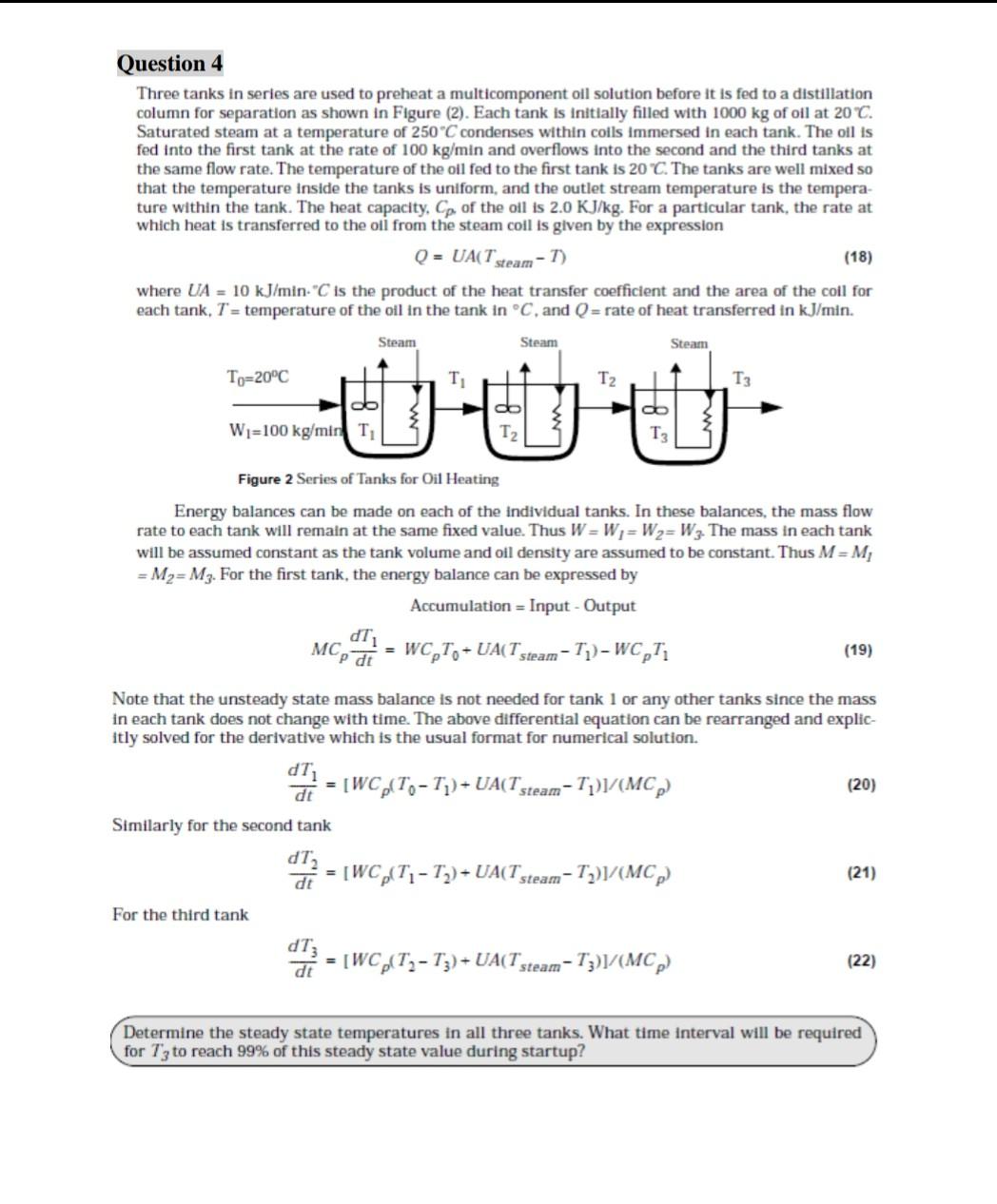Answered step by step
Verified Expert Solution
Question
1 Approved Answer
Find the solution using polymath software Three tanks in series are used to preheat a multicomponent oll solution before it is fed to a distillation

Find the solution using polymath software
Three tanks in series are used to preheat a multicomponent oll solution before it is fed to a distillation column for separation as shown in Figure (2). Each tank is initially filled with 1000kg of oll at 20C. Saturated steam at a temperature of 250C condenses within coils immersed in each tank. The oll is fed into the first tank at the rate of 100kg/min and overflows into the second and the third tanks at the same flow rate. The temperature of the oil fed to the first tank is 20C. The tanks are well mixed so that the temperature inside the tanks is uniform, and the outlet stream temperature is the temperature within the tank. The heat capacity, Cp of the ofl is 2.0KJ/kg. For a particular tank, the rate at which heat is transferred to the oll from the steam coll is given by the expression Q=UA(TsteamT) where UA=10kJ/minC is the product of the heat transfer coefficient and the area of the coll for each tank, T= temperature of the oil in the tank in C, and Q= rate of heat transferred in kJ/min. Figure 2 series of lanks lor un Heating Energy balances can be made on each of the individual tanks. In these balances, the mass flow rate to each tank will remain at the same fixed value. Thus W=WI=W2=W3. The mass in each tank will be assumed constant as the tank volume and ofl density are assumed to be constant. Thus M=MI =M2=M3. For the first tank, the energy balance can be expressed by Accumulation=Input-OutputMCpdtdT1=WCpT0+UA(TsteamT1)WCpT1 Note that the unsteady state mass balance is not needed for tank 1 or any other tanks since the mass in each tank does not change with time. The above differential equation can be rearranged and explicitly solved for the derivative which is the usual format for numerical solution. dtdT1=[WC(T0T1)+UA(TsteamT1)]/(MC) Similarly for the second tank dtdT2=[WCp(T1T2)+UA(TsteamT2)]/(MCp) For the third tank dtdT3=[WC(T2T3)+UA(TsteamT3)]/(MC) Determine the steady state temperatures in all three tanks. What time interval will be required for T3 to reach 99% of this steady state value during startup? Three tanks in series are used to preheat a multicomponent oll solution before it is fed to a distillation column for separation as shown in Figure (2). Each tank is initially filled with 1000kg of oll at 20C. Saturated steam at a temperature of 250C condenses within coils immersed in each tank. The oll is fed into the first tank at the rate of 100kg/min and overflows into the second and the third tanks at the same flow rate. The temperature of the oil fed to the first tank is 20C. The tanks are well mixed so that the temperature inside the tanks is uniform, and the outlet stream temperature is the temperature within the tank. The heat capacity, Cp of the ofl is 2.0KJ/kg. For a particular tank, the rate at which heat is transferred to the oll from the steam coll is given by the expression Q=UA(TsteamT) where UA=10kJ/minC is the product of the heat transfer coefficient and the area of the coll for each tank, T= temperature of the oil in the tank in C, and Q= rate of heat transferred in kJ/min. Figure 2 series of lanks lor un Heating Energy balances can be made on each of the individual tanks. In these balances, the mass flow rate to each tank will remain at the same fixed value. Thus W=WI=W2=W3. The mass in each tank will be assumed constant as the tank volume and ofl density are assumed to be constant. Thus M=MI =M2=M3. For the first tank, the energy balance can be expressed by Accumulation=Input-OutputMCpdtdT1=WCpT0+UA(TsteamT1)WCpT1 Note that the unsteady state mass balance is not needed for tank 1 or any other tanks since the mass in each tank does not change with time. The above differential equation can be rearranged and explicitly solved for the derivative which is the usual format for numerical solution. dtdT1=[WC(T0T1)+UA(TsteamT1)]/(MC) Similarly for the second tank dtdT2=[WCp(T1T2)+UA(TsteamT2)]/(MCp) For the third tank dtdT3=[WC(T2T3)+UA(TsteamT3)]/(MC) Determine the steady state temperatures in all three tanks. What time interval will be required for T3 to reach 99% of this steady state value during startupStep by Step Solution
There are 3 Steps involved in it
Step: 1

Get Instant Access to Expert-Tailored Solutions
See step-by-step solutions with expert insights and AI powered tools for academic success
Step: 2

Step: 3

Ace Your Homework with AI
Get the answers you need in no time with our AI-driven, step-by-step assistance
Get Started


